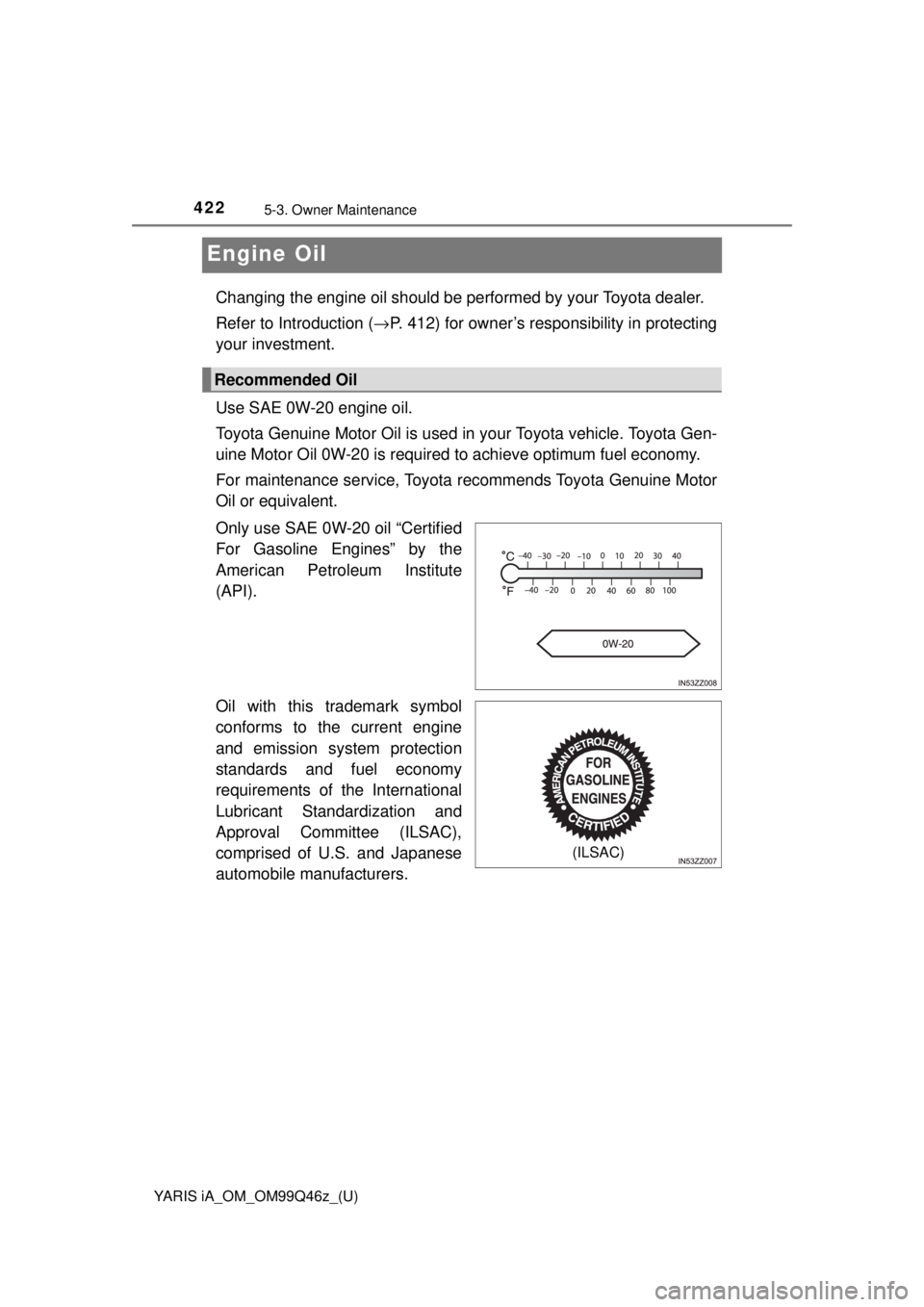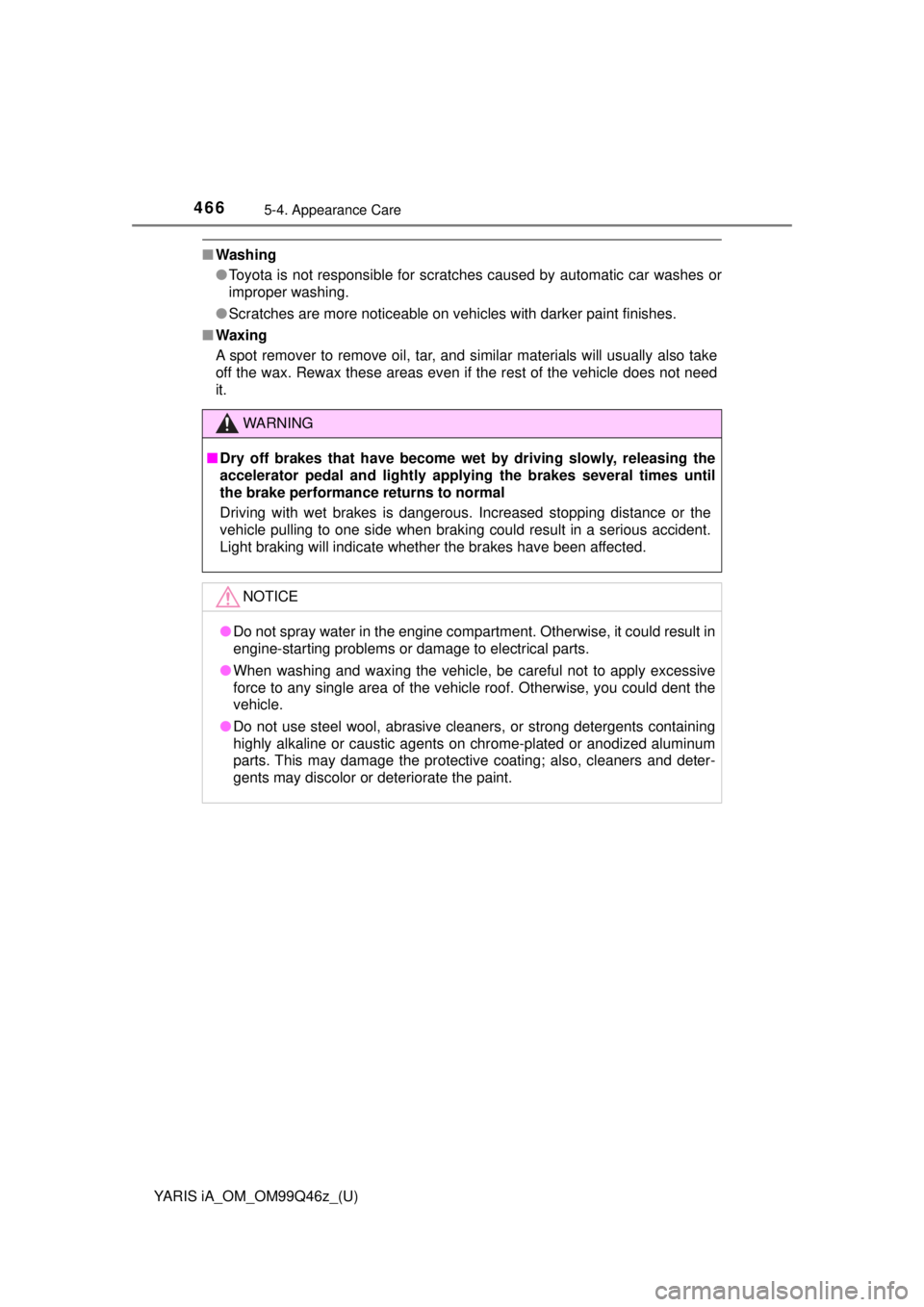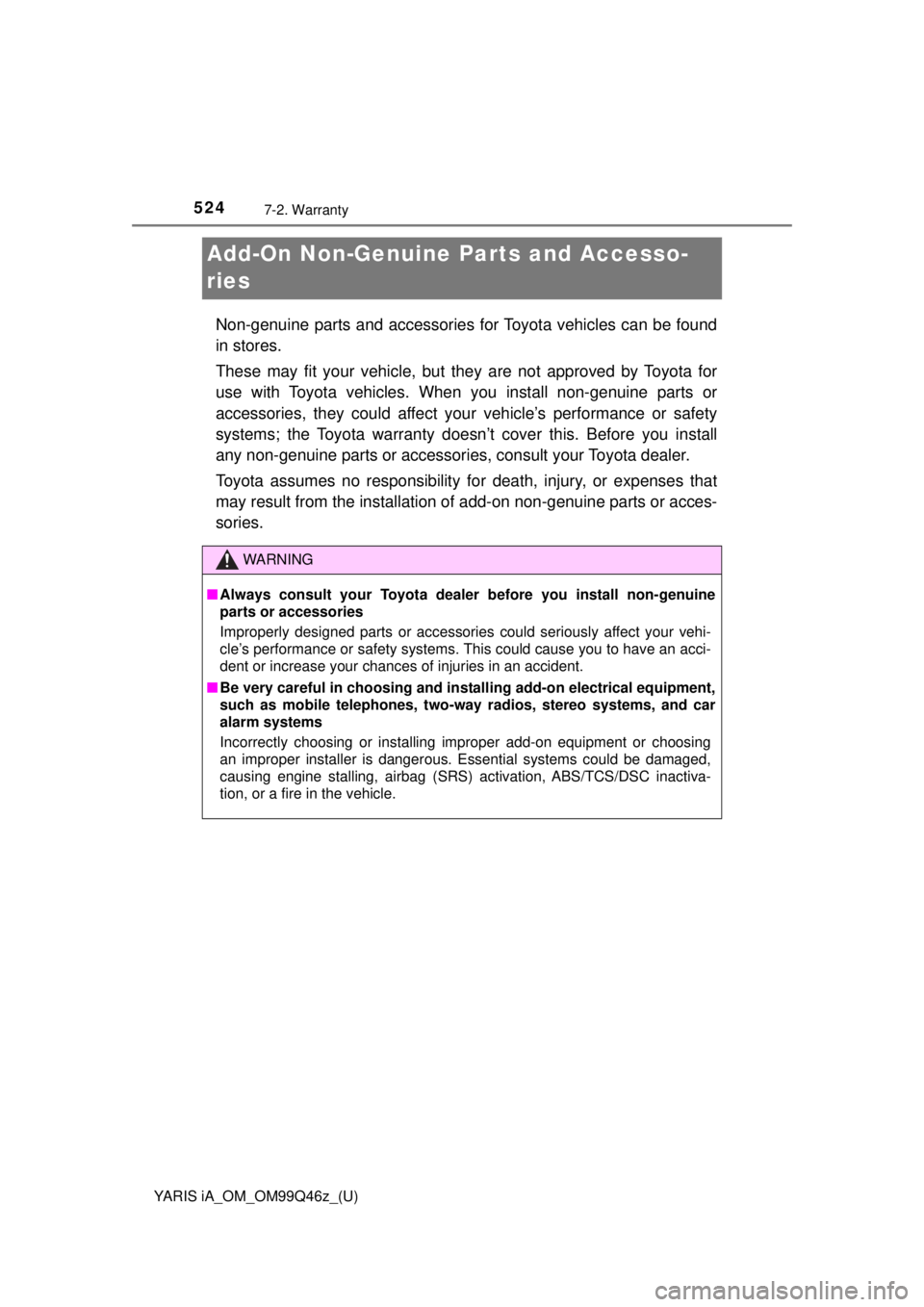2018 TOYOTA YARIS iA ESP
[x] Cancel search: ESPPage 412 of 576

412
YARIS iA_OM_OM99Q46z_(U)
5-1. Essential Information
Introduction
Be careful not to hurt yourself when inspecting your vehicle, replacing
a tire, or doing some kind of maintenance such as car washing.
In particular, wear thick work gloves such as cotton gloves when
touching areas that are difficult to see while inspecting or working on
your vehicle. Doing inspections or procedures with your bare hands
could cause injury.
If you are unsure about any procedu re it describes, we strongly urge
you to have a reliable and qualified service shop perform the work,
preferably your Toyota dealer.
Factory-trained Toyota technicians and genuine Toyota parts are best
for your vehicle. Without this expe rtise and the parts that have been
designed and made especially for your Toyota, inadequate, incom-
plete, and insufficient servicing may result in problems. This could
lead to vehicle damage or an accident and injuries.
For expert advice and quality service, consult your Toyota dealer.
To continue warranty eligibility and to protect your investment, it is
your responsibility to pr operly maintain your vehicle according to fac-
tory recommended schedul es outlined in this manual. Keep a copy of
the repair order. It proves that the maintenance that has been per-
formed is under warranty coverage. If any problem should arise while
your vehicle is under warranty, your Toyota dealer will promptly take
care of it.
This evidence may consist of the following: • The Maintenance Log, found within the Warranty and Maintenance Guide, must be completely filled out showing mileage, repair order
number, date for each service, and signed by a qualified automotive
service technician who service vehicles.
• Original copies of repair orders or other receipts that include the mileage and date the vehicle was serviced. Each receipt should be
signed by a qualified automot ive service technician.
• For self maintenance, a statemen t that you completed the mainte-
nance yourself, displaying mileag e and the date the work was per-
formed. Also, receipts for the replac ement parts (fluid, filters, etc.)
indicating the date and mileage mu st accompany this statement.
Page 417 of 576

417
YARIS iA_OM_OM99Q46z_(U)
5-3. Owner Maintenance
5
Maintenance and Care
Owner Maintenance Precautions
The owner or a qualified service technician should make these vehicle
inspections at the indicated inte rvals to ensure safe and dependable
operation.
Bring any problem to the attention of your Toyota dealer or qualified
service technician as soon as possible.
■When Refueling • Brake and clutch fluid level ( →P. 428)
• Engine coolant level ( →P. 425)
• Engine oil level ( →P. 424)
• Washer fluid level ( →P. 429)
■At Least Monthly
• Tire inflation pressures ( →P. 439)
■At Least Twice a Year (For Example, Every Spring and Fall)
You can do the following scheduled maintenance items if you have
some mechanical ability and a few basic tools and if you closely fol-
low the directions in this manual.
• Engine coolant ( →P. 425)
• Engine oil ( →P. 422)
Improper or incomplete service may result in problems. This section
gives instructions only for items that are easy to perform.
As explained in the Introduction ( →P. 412), several procedures can be
done only by a qualified service technician with special tools.
Improper owner maintenance during the warranty period may affect
warranty coverage. Refer to Introduction ( →P. 412) for owner’s
responsibility in protecting your in vestment. For details, read the sep-
arate Toyota Warranty and Mainten ance Guide provided with the vehi-
cle. If you are unsure about any se rvicing or maintenance procedure,
have it done by your Toyota dealer.
There are strict environmental laws regarding the disposal of waste oil
and fluids. Please dispose of your waste properly and with due regard
to the environment.
We recommend that you entrust the oil and fluid changes of your vehi-
cle to your Toyota dealer.
Page 418 of 576

4185-3. Owner Maintenance
YARIS iA_OM_OM99Q46z_(U)
WARNING
■Do not perform ma intenance work if you l ack sufficient knowledge and
experience or the proper tools an d equipment to do the work. Have
maintenance work done by a qualified technician
Performing maintenance work on a vehicle is dangerous if not done prop-
erly. You can be seriously injured while performing some maintenance pro-
cedures.
■ If you must run the engine while working under the hood, make certain
that you remove all jewelry (especially rings, bracelets, watches, and
necklaces) and all neckties, scarves, and similar loose clothing before
getting near the engine or coolin g fan which may turn on unexpectedly
Working under the hood with the engine running is dangerous. It becomes
even more dangerous when you wear jewelry or loose clothing.
Either can become entangled in moving parts and result in injury.
■ Switch the ignition to off and make sure the fan is not running
before attempting to work near the cooling fan
Working near the cooling fan when it is running is dangerous. The fan could
continue running indefinitely even if the engine has stopped and the engine
compartment temperature is high. You could be hit by the fan and seriously
injured.
■ Do not leave items in th e engine compartment
After you have finished checking or doing servicing in the engine compart-
ment, do not forget and leave items such as tools or rags in the engine com-
partment.
Tools or other items left in the engine compartment could cause engine
damage or a fire leading to an unexpected accident.
Page 422 of 576

422
YARIS iA_OM_OM99Q46z_(U)
5-3. Owner Maintenance
Engine Oil
Changing the engine oil should be performed by your Toyota dealer.
Refer to Introduction (→P. 412) for owner’s responsibility in protecting
your investment.
Use SAE 0W-20 engine oil.
Toyota Genuine Motor Oil is used in your Toyota vehicle. Toyota Gen-
uine Motor Oil 0W-20 is required to achieve optimum fuel economy.
For maintenance service, Toyota recommends Toyota Genuine Motor
Oil or equivalent.
Only use SAE 0W-20 oil “Certified
For Gasoline Engines” by the
American Petroleum Institute
(API).
Oil with this trademark symbol
conforms to the current engine
and emission system protection
standards and fuel economy
requirements of the International
Lubricant Standardization and
Approval Committee (ILSAC),
comprised of U.S. and Japanese
automobile manufacturers.
Recommended Oil
(ILSAC)
Page 466 of 576

4665-4. Appearance Care
YARIS iA_OM_OM99Q46z_(U)
■Washing
●Toyota is not responsible for scratches caused by automatic car washes or
improper washing.
● Scratches are more noticeable on vehicles with darker paint finishes.
■ Waxing
A spot remover to remove oil, tar, and similar materials will usually also take
off the wax. Rewax these areas even if the rest of the vehicle does not need
it.
WARNING
■Dry off brakes that have become wet by driving slowly, releasing the
accelerator pedal and lightly applyi ng the brakes several times until
the brake performance returns to normal
Driving with wet brakes is dangerous. Increased stopping distance or the
vehicle pulling to one side when braking could result in a serious accident.
Light braking will indicate whether the brakes have been affected.
NOTICE
● Do not spray water in the engine compartment. Otherwise, it could result in
engine-starting problems or damage to electrical parts.
● When washing and waxing the vehicle, be careful not to apply excessive
force to any single area of the vehicle roof. Otherwise, you could dent the
vehicle.
● Do not use steel wool, abrasive cleaners, or strong detergents containing
highly alkaline or caustic agents on chrome-plated or anodized aluminum
parts. This may damage the protective coating; also, cleaners and deter-
gents may discolor or deteriorate the paint.
Page 479 of 576

YARIS iA_OM_OM99Q46z_(U)
4796-2. Flat Tire
6
If Trouble Arises
Your Toyota has a temporary spare tire. The temporary spare tire is
lighter and smaller than a conventional tire, and is designed only for
emergency use and should be used only for VERY short periods.
Temporary spare tires should NEVER be used for long drives or
extended periods.
■To remove the spare tire
Lift the trunk mat.
Turn the spare tire hold-down
bolt counterclockwise.
■To secure the spare tire
Store the spare tire in the reverse order of removal. After storing,
verify that the spare tire is stored securely.
Spare Tire
1
Spare tire hold-down bolt2
WARNING
■Do not install the temporary spare tire on the front wheels (driving
wheels)
Driving with the temporary spare tire on one of the front driving wheels
is dangerous. Handling will be affected . You could lose control of the
vehicle, especially on ice or snow bound roads, and have an accident.
Move a regular tire to the front wheel and install the temporary spare tire
to the rear.
Page 524 of 576

524
YARIS iA_OM_OM99Q46z_(U)
7-2. Warranty
Add-On Non-Genuine Parts and Accesso-
ries
Non-genuine parts and accessories for Toyota vehicles can be found
in stores.
These may fit your vehicle, but th ey are not approved by Toyota for
use with Toyota vehicles. When you install non-genuine parts or
accessories, they coul d affect your vehicle’s performance or safety
systems; the Toyota warranty doesn’t cover this. Before you install
any non-genuine parts or accessor ies, consult your Toyota dealer.
Toyota assumes no responsibility fo r death, injury, or expenses that
may result from the installation of add-on non-genuine parts or acces-
sories.
WARNING
■ Always consult your Toyota dealer before you install non-genuine
parts or accessories
Improperly designed parts or accessories could seriously affect your vehi-
cle’s performance or safety systems. This could cause you to have an acci-
dent or increase your chances of injuries in an accident.
■ Be very careful in choosing and inst alling add-on electrical equipment,
such as mobile telephones, two-w ay radios, stereo systems, and car
alarm systems
Incorrectly choosing or installing improper add-on equipment or choosing
an improper installer is dangerous. Essential systems could be damaged,
causing engine stalling, airbag (SRS ) activation, ABS/TCS/DSC inactiva-
tion, or a fire in the vehicle.
Page 525 of 576

525
YARIS iA_OM_OM99Q46z_(U)
7-3. Cell Phones
7
Customer Information and Reporting Safety Defects
Cell Phones Warning
WARNING
■Please comply with the legal regula tions concerning the use of com-
munication equipment in vehicles in your country
Use of any electrical devices such as cell phones, computers, portable
radios, vehicle navigation or other devices by the driver while the vehicle is
moving is dangerous. Dialing a number on a cell phone while driving also
ties-up the driver’s hands. Use of these devices will cause the driver to be
distracted and could lead to a serious accident. If a passenger is unable to
use the device, pull off the right-of-way to a safe area before use.
If use of a cell phone is necessary despite this warning, use a hands-free
system to at least leave the hands free to drive the vehicle. Never use a cell
phone or other electrical devices while the vehicle is moving and, instead,
concentrate on the full-time job of driving.